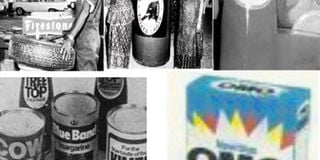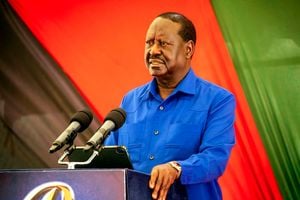When industrial giants went on charm offensive

The High Fidelity Studios, produced some of the finest commercials of the 1960s, 1970s, and 1980s. The brands they promoted became household names. Some were imported, many were made locally. Kenya Breweries, East African Industries, and Bata Shoe Company were the industrial giants that fought for the hearts and minds of consumers. PHOTO/FILE
What you need to know:
- A variety of goods hit the Kenyan market in the ’60s and ’70s as the economy boomed and consumption rose. How their makers won over the buying class.
- Some of these products have stood the test of time and continue to thrive, yet others fell by the wayside.
The High Fidelity Studios, owned by Peter Colmore and Stephen Ndesanjo, produced some of the finest commercials of the 1960s, 1970s, and 1980s.
The brands they promoted became household names. Some were imported, many were made locally.
Kenya Breweries, East African Industries, and Bata Shoe Company were the industrial giants that fought for the hearts and minds of consumers.
Some of these products have stood the test of time and continue to thrive, yet others fell by the wayside.
The commercials were recorded by the finest broadcasters and musicians of the time.
The promotions intensified as a multitude of new brands entered the market at a time when the economy was recording high growth and its middle class was increasing.
Some of the jingles were recorded by the marketing wing of the state-owned Voice of Kenya as it became the sole avenue to reach out to villages and urban centres.
Names such as Stephen Kikumu, Leonard Mambo Mbotela, and veteran football commentator, Salim Mohamed, Fred Obachi Machoka, Amina Fakih, and Jean Mwenda Bosco, a Congolese musician who lived in Kenya, featured prominently.
This is the story of the famous brands.
HAIG SCOTCH WHISKY
Don’t be Vague! Ask for Haig was the advert of the ’60s and ’70s in Kenya. Its jingle signature tune was composed by the Kenya Police Band wing headed by Gideon Mwanyiga and the voice-over done by his officer, a Mr Njuguna.
Before it was corrupted by the 10th Parliament, the Haig (pronounced Hague) advert marked the penetration of the Scotch whisky brand into the African market since this promotion was mooted in 1934.
Haig was one of the finest whiskies in the market then. Bottled in a short stout bottle with a stamp-like marked level, it was drunk by the elite in the leafy suburbs and cocktails in four- and five-star hotels around the country. Its only competitors then were VAT 69 — created by William Sanderson in 1882 — Teachers, Black and White, Bell’s Old Scotch Whisky, and White Horse.
The popularity of Haig has gone down and today, it is only found in bars in five-star hotels.
PRINCESS PATRA
Before it was banned, Princess Patra was the skin complexion cream of choice for airhostesses and women of substance.
Its flagrance made heads turn. Like other leading products, it had promotions on English and Kiswahili radio and television.
Leonard Mambo Mbotela did the Kiswahili version of the jingle, Princess Patra, ni mafuta ya kujirembesha (beauty lotion).
It was banned in the 1990s after it was found to contain a skin bleaching substance. Other cosmetics affected were Ambi Special, Body Clear, Fair Lady, Envi, Lolane, Jambo, and Claire.
SANYO
Popularised by the Sanyo Juu Sanyo Tops radio programme in the ’70s and ’80s, this was a radio and radiogram that had been in the market for decades.
Popular with the generation of youthful job beginners and university students in the 1970s, the automatic record players had come to rival the wind-up gramophone.
While Fred Obachi Machoka later became the face of the programme, he had only become its host accidentally by winning a radio in one of its competitions.
He was asked by the producer to do a small five-minute slot. He later took over the entire radio programme, Sanyo Juu, Sanyo Tops, on VoK.
The Bee Gees Stayin Alive hit was the official opening song for the programme.
ASPRO
This was the marketing name of the drug aspirin and was popular in relieving headaches.
A controversial drug that had originated from Australia during the First World War to replace the German aspirin tablets, its name was changed to Aspro in 1917.
In Kenya, the tablet was sold over the counter and the local promotion television showed a man in pain massaging his head.
One could hear the voice of Jean Mwenda Bosco chanting in Kiswahili, Aspro, ni dawa ya kweli (Aspro is the real medicine.)
ODORONO
This deodorant had nothing to do with Peter Townsend’s 1967 single hit by the same name.
It was popular spray touted to prevent sweat and odour and became one of the most successful early brands of commercial deodorants.
Its advertisement was in Kiswahili: Odorono, marashi bora ya mwili wako (the best deodorant for your body).
SWEET MENTHOL
Introduced in 1966 in Kenya by British American Tobacco, its target was the “younger, smartish” people, especially the growing women’s market.
Commonly known as SM, it was popularised during the last two decades by the jingle SM ni sigara maalum and “Sweet Menthol is smooth… all the way”. The voice over was done by veteran broadcaster Salim Mohamed.
At one point the promotion made it rival such sister brands like Sportsman, even with its Sawa hasa jingle by Fred Obachi Machoka.
Other brands competing for space included Benson and Hedges, Rex, Nyota, Ten Cent, Rooster, and Embassy.
There was also the short-lived Grenadier by the Rothman company where former vice-president Joseph Murumbi was a director.
Leonard Mambo Mbotela did the voice over whose message was Badilisha, vuta Grenadier while Stephen Kikumu voiced the English version, Change, smoke grenadier.
This was long before smoking was associated with health problems including cancer. Today, Kenya has banned smoking in public and the advertising of cigarettes.
OMO
Registered in the UK in 1908, Omo entered the Kenyan market in 1958. The acronym Omo stands for “Old Mother Owl” and is today one of the oldest detergents in Kenya.
Over the years, it has been marketed as Blue Omo, New Blue Omo, Omo, and now Omo — Dirt is Good. Its commercials have always attracted famous musicians and at one point the Orchestra African Fiesta of Tabu Ley composed Savon Omo from Kinshasa in its praise.
In Kenya, the advertisement has gone through several changes, including the original Omo ni sabuni bora, New Blue washes brighter, and it shows, to the Dirt is good commercial.
The detergent has fought legal battles in court corridors over time to maintain its dominance. It is currently involved in a court case with its rival, Ariel.
KIMBO and COWBOY
From the East African Industries, these two remained the cooking fat of choice for many years.
Kimbo was the acronym of Kenya Industrial Management Board, a company set up to provide World War II products before it was commercialised into East African Industries (EAI) and now Unilever.
While Kimbo was a pure refined palm oil, Cowboy was used for making chapatis. The two brands, however, faced severe competition in the ’90s and were sold to Thika-based Bidco. Kimbo’s promotion jingle was Pika kwa Kimbo, done by VoK’s veteran broadcaster Amina Fakih.
FIRESTONE and TIMEX
This was a joint commercial between tyre manufacturers Firestone (now Sameer) and the makers of the Timex watch.
The watch was tied on the wheel of a truck and driven along rough terrain and when it stopped it still was: Timex on time, Firestone in any terrain!
The commercial was popular in villages across the country, taken there by mobile cinemas.
ALLSOPS and TUSKER
During the ’60s and ’70s, Allsops was one of the leading beer brands in East Africa.
This was before Pilsner. It disappeared, but is now back.
Its commercial was promoted by a leading comedian, Kipanga Athumani, on his VoK programme, Cheka na Kipanga.
Tusker, the oldest beer brand in East Africa and founded in 1922, remains the leading alcoholic beverage in the region, known even overseas.
Its commercial, Baada ya Kazi, was popular over the years. Another beer brand that riveted the nation was City lager (by City Breweries) before it was bought by East African Breweries in 1969.
EVEREADY and NATIONAL
The two torch and radio batteries of the decade were Eveready and National.
While Eveready was manufactured in Nakuru from 1967, by an American company, the National, a full metal-jacket dry cell battery, was manufactured in Dar es salaam, Tanzania, by Panasonic.
However, aggressive commercials by Eveready drove National out of the market, becoming one of the leading brands for dry cells such as Eveready! Paka Power, again done by Machoka.
BATA PREFECT
Designed and manufactured by Bata Shoe Company in Limuru, it has endured over the years as the shoe for school-going children.
Its commercial, Back to School, is one of the few which has not changed over the years.
But Bata had other products such as Bata Bullets, North Star, Bubblegummers, and Safari boots, the shoes that say you know Africa.
TREETOP
It was a juice made from various fruits — orange, passion fruit, and even lemons.
A product of Unilever (EAI), it was popular among boarding school students whose shopping would not be complete without it.
The Treetop ni maisha bora commercial was a common tune on VoK radio and television.
It went out of circulation following stiff competition from ready-to-drink juices packaged in plastic bottles.




